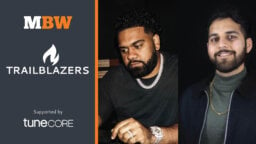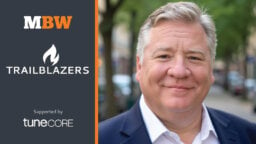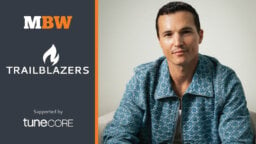Trailblazers is an MBW interview series that turns the spotlight on music entrepreneurs with the potential to become the global business power players of tomorrow. This time, we meet Head of Range Music Publishing, Casey Robison, and VP of A&R, Sam Drake. Trailblazers is supported by TuneCore.
In less than a year since launching, Range Music Publishing has ticked off a number of big wins at radio and on the US charts for its growing roster of songwriter clients.
The division, which forms part of the Range Music and Media Partners ecosystem, reps Sean Cook, who co-wrote Shaboozey’s current Billboard Hot 100 No.1, A Bar Song (Tipsy).
It has also celebrated wins with another Cook co-write, Lil Boo Thang by Paul Russell, which reached No.5 on the Top 40 radio chart. Writers Geoff Warburton and Tyler Dopps have hit No.1 at country and dance radio with tracks for Tyler Hubbard and Loud Luxury, respectively.
Range Publishing is administered by UMPG and led by Casey Robison, who attributes the early success to his team’s hands-on approach and the ambitions of the creatives they are working with.
“Our greatest appeal is the service that we can provide and finding writers and artists who are looking for that,” he says. “Ultimately, it’s about finding people who have a shared vision for what they want as they build their careers. That’s what it all comes down to.”
Casey was previously co-President and Partner of Big Deal Music, where he learned how to build a full-service publishing company from the ground up. He’s joined by Sam Drake as VP of A&R, who previously spent seven years at Sony Music Publishing.
Range Media, which launched four years ago, offers a multitude of services across music management, film, TV, sports, digital and branding. This offering, says Robison, is a key part of what makes the publishing arm competitive.
“We really see an opportunity in the marketplace to build and grow a full service, independent publishing company within the Range ecosystem,” he says.
“WE REALLY SEE AN OPPORTUNITY IN THE MARKETPLACE TO BUILD AND GROW A FULL SERVICE, INDEPENDENT PUBLISHING COMPANY.”
CASEY ROBISON
He adds: “Range is an incredibly dynamic company with various verticals and [it’s made up of] a community of incredibly dynamic creatives who are working with amazing artists on the music management side as well as creators in film, TV, branding and sports.
“The writers we sign have access to all these different resources to build long-lasting careers. That really differentiates us.”
Cook and Shaboozey are examples of the company cross-pollinating its talent: both are co-managed by Range Partner Jared Cotter.
Range Founding Partner, Matt Graham, says the publishing division was on the cards from the get-go.
“When we started Range in 2020, we always intended to build a publishing business,” says Graham. “It took some time to find the right people to lead that effort, and we feel very fortunate we didn’t rush. Sam and Casey are truly the right individuals to help achieve this vision and set our true north of guiding the next great indie publishing business.”
Here, we chat to Robison and Drake about their ambitions, approach to A&R and working with creative talent, and a few big-picture issues concerning the music business and publishing at large.
WHAT ARE YOUR ULTIMATE AMBITIONS FOR RANGE PUBLISHING?
Casey Robison: Our vision is to build a full service, independent publishing company that can compete with the best publishers within the music landscape. I think we will always be boutique, where we can really provide that service and focus but ultimately, our ambition is high.
SAM, CAN YOU DEFINE YOUR APPROACH TO A&R AND GETTING THE BEST OUT OF THE CREATIVE TALENT THAT YOU’RE WORKING WITH?
Sam Drake: For us, the approach is signing best in class talent. We’re looking for creatives that share a very similar vision to us, whether that’s a similar vision when it comes to partnership, collaboration, strategy or when it comes to the overall creative process. We’re looking for a common thread that links all of the creatives that we work with to the larger songwriter community. We want to work with writers and producers that are receptive to that idea and want an active partner and to be a larger part of the Range ecosystem.
IT’S SAID TO BE HARDER THAN EVER TO CREATE AND SUSTAIN A CAREER IN MUSIC TODAY DUE TO THE WEALTH OF COMPETITION THAT’S OUT THERE. WHAT’S YOUR PERSPECTIVE ON THAT?
Casey Robison: It’s never been easy to be a creative, to find inspiration and to be able to monetize that. But I do think that in the ever shifting landscape of music, there’s a lot of opportunity. That’s both exciting and challenging. If you’re a writer and an artist who has a certain perspective and is looking to build their team, and you make the right decisions and find people with similar views, you can build great partnerships. That makes it a lot easier to have success and to be able to sustain that inspiration.
WHAT ARE SOME OF YOUR STRATEGIES FOR CUTTING THROUGH THE NOISE WITH A SONG?
Casey Robison: Knowledge, great talent and growing and curating songwriters and artists within this larger community that we’re a part of and that we’re building.
Sam Drake: It’s the traditional A&R approach but adding all of the other aspects within Range. That’s really our cutting edge and also our bandwidth. We have a bespoke roster and we plan to keep it that way. As we grow, we’ll grow our A&R staff. That’s our biggest strength: actually having the time and the bandwidth to be a great partner.
SAM, WHAT’S THE MOST EXCITING THING ABOUT WORKING IN PUBLISHING TODAY?
Sam Drake: It’s kind of twofold. The most exciting and the most challenging thing is the ever changing aspect of the music industry. You have songs that are coming seemingly out of nowhere, even though it’s a longer process than what it appears. The economics of a song have changed, which is the challenging part. But having more content out there provides more opportunities for our writers. There’s enough to go around for everyone at the end of the day.
CASEY, WOULD YOU HAVE ANYTHING DIFFERENT TO ADD TO THAT?
Casey Robison: There’s inherent challenges to the post-Covid streaming world that we’re living in. But we co-publish Shaboozey’s A Bar Song (Tipsy), which came out in April, and within just a matter of days of its release, it became one of the biggest songs in the world. No one could predict that happening.
Because of the confluence of various factors within the marketplace, it being an incredible song, him being an incredible artist, and the realities of streaming, it was a great example of how things can work in today’s marketplace, which is very different from five to 10 years ago. We’re seeing that regularly — an artist releases a song and, very quickly, it resonates with millions of people around the world. That could only happen today.
CAN YOU DEFINE WHAT YOU MEAN BY THE POST-COVID STREAMING LANDSCAPE? HOW DID THE PANDEMIC HAVE AN IMPACT ON STREAMING?
Casey Robison: During the pandemic, we saw an acceleration of trends that were already happening. Whether it was more people streaming versus listening to terrestrial radio, partly because fewer people were in their cars for an extended period of time.
“PEOPLE GETTING THEIR MUSIC FROM SOCIAL MEDIA WAS A TREND THAT WAS ALREADY OBVIOUSLY VERY MUCH IN PLACE PRE-COVID BUT NOW, IT’S FIRMLY IN PLACE.”
It reinforced the trend of people streaming music, rather than going to their traditional outlets for finding music and talent.
We all were in our houses for a very long period of time and we were on our phones. People getting their music from social media was a trend that was already obviously very much in place pre-Covid but now, it’s firmly in place. That’s how most people are now receiving their music and learning about new artists and entertainment across the board.
AI IS A BIG ISSUE THE MUSIC BUSINESS IS GRAPPLING WITH RIGHT NOW. DOES IT CONCERN YOU?
Casey Robison: There’s tremendous opportunity that comes from AI. There’s also challenges that we will be facing as we navigate this new world. It’s hard to predict what those are but I’m sure they will exist. I’m an optimist so I’m always excited about the opportunities that will come from technology like that.
“OUR BIGGEST DESIRE WHEN IT COMES TO AI IS THAT OUR SONGWRITERS ARE FAIRLY COMPENSATED AND THEY’RE ABLE TO UTILIZE AI IN A WAY THAT HELPS THE CREATIVE PROCESS, INSTEAD OF HINDERING IT.”
Sam Drake: Our biggest desire when it comes to AI is that our songwriters are fairly compensated and they’re able to utilize AI in a way that helps the creative process, instead of hindering it.
ANOTHER BIG PICTURE ISSUE THAT’S AFFECTING PUBLISHING IN PARTICULAR IS THAT SPOTIFY RECENTLY DECIDED TO RECLASSIFY ITS PREMIUM SUBSCRIPTION TIERS AS BUNDLES, CAUSING A REDUCTION IN MECHANICAL ROYALTY PAYOUTS. WHAT DO YOU MAKE OF THAT MOVE?
Casey Robison: We’re supporters and members of David Israelite and the NMPA and our top priority is advocating for our songwriters and ensuring that songwriters and publishers get paid equitably. We have real concerns about that move. We all are waiting to see how that truly plays out and how it affects how songwriters are getting paid.
HOW DO YOU SEE PUBLISHING EVOLVING IN FUTURE?
Casey Robison: I think there’s going to continue to be real opportunity for independents like ourselves, whose model is based on providing service and being great partners.
The business is continuing to change, there’s different publishers of different sizes, but as publishing evolves, there’s going to continue to be a real opportunity for the indies. It goes back to one of your earlier questions about what is necessary for a writer and an artist to have real success. It’s having great partners that come to the table and can help support true artistry and creativity.
WHY IS NOW A PARTICULARLY GOOD TIME FOR INDEPENDENTS?
Casey Robison: As we talked about earlier, because there is so much music, so much content being released, there’s a real need for true partnerships and publishers that can really be involved in the trenches, helping to cultivate great talent and build out creative networks. To be pitching songs and doing all the nuts and bolts of things that are involved in publishing, the things that really excite us.
HERE’S A QUESTION FOR BOTH OF YOU: WHAT WOULD YOU CHANGE ABOUT THE MUSIC INDUSTRY AND WHY?
Casey Robison: I would have songwriters get paid more. In music, it all starts with a song. Songwriters need to be getting fairly compensated, they need to get paid more for their work.
DO YOU WANT TO GET ANY MORE SPECIFIC ABOUT WHAT GETTING PAID MORE MIGHT LOOK LIKE?
Casey Robison: It’s negotiating rates that are more favorable for songwriters. That pertains to streaming rates as well as rates for different types of performance, whether it’s public performance or streaming.
Sam Drake: It’s about increasing rates across the board. That’s our number one goal and our number one biggest challenge and I hope we can change that. David Israelite, the NMPA and other amazing organizations are doing a lot to change that and the future does look bright. We want to continue to fight for those rights.
AS A COMPANY, YOU’VE HAD SOME EARLY SUCCESS ON RADIO. HOW IMPORTANT IS IT TO YOU AS A FORMAT TODAY?
Casey Robison: For writers and publishers, radio is still really important. It’s still an important driver of revenue, even as streaming is becoming dominant. One of the reasons why we’re advocating for an increase in royalty rates is because so much of publishing revenue is driven by radio performance revenue. We need to see increases in these other areas to really help sustain songwriters and publishers.






